University Accounting Theory and Practice Workshop 8 Assignment
VerifiedAdded on 2023/04/23
|9
|1198
|461
Homework Assignment
AI Summary
This assignment solution addresses key concepts in accounting theory and practice, focusing on changes in accounting policies and estimates. Question 1 differentiates between changes in accounting policy (e.g., revaluation method) and changes in accounting estimate (e.g., depreciation method), detailing their accounting treatments and impact on financial statements. Question 2 discusses the handling of prior period errors, emphasizing adjustments to opening equity based on the practicability of tracing the error. Question 3 examines a change in warranty provision and a prior period error. Question 4 provides journal entries and balance sheet extracts for various scenarios including warranty expenses, staff welfare expenses, excess depreciation, and doubtful debts, illustrating their impact on the profit and loss account and balance sheet. The solution incorporates references to relevant accounting standards and literature.
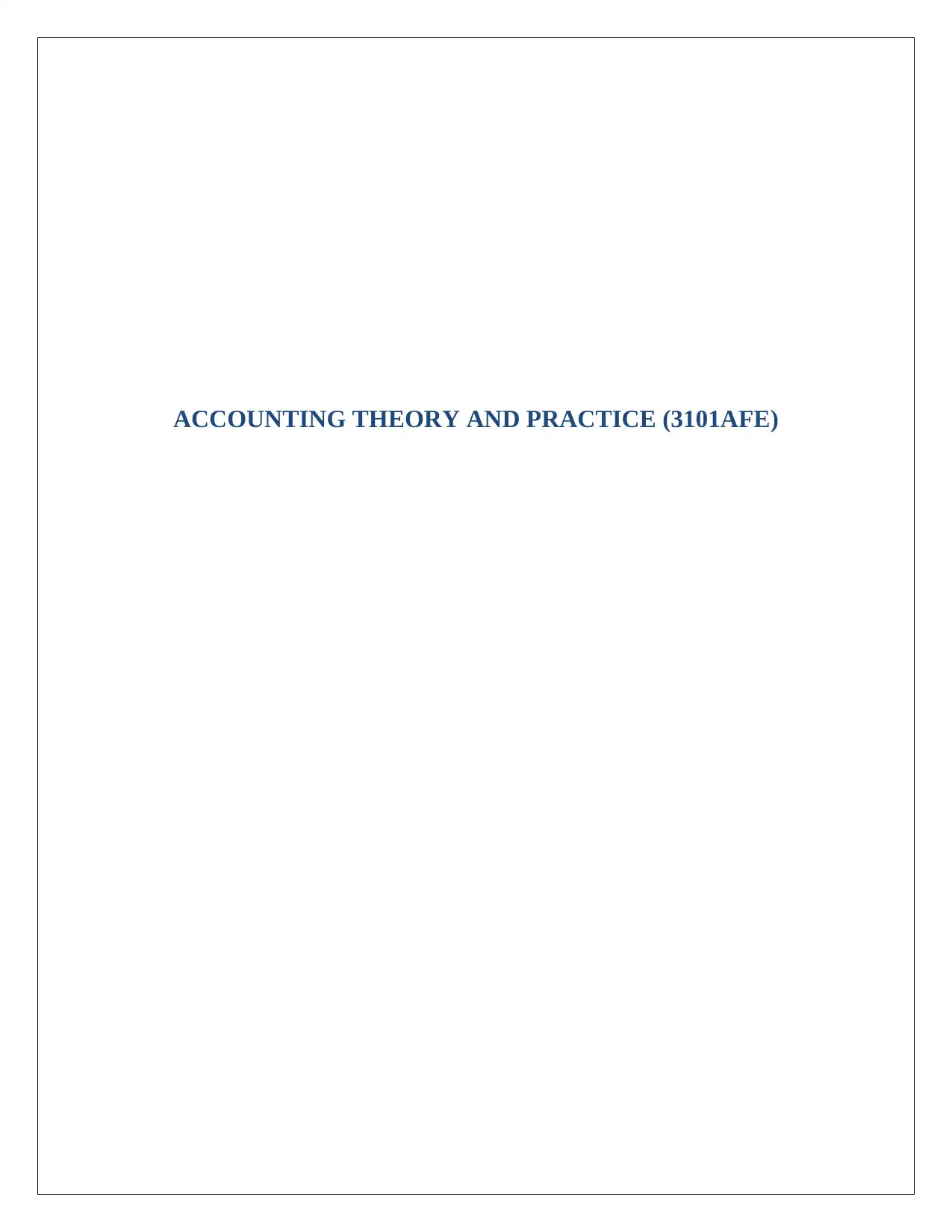
ACCOUNTING THEORY AND PRACTICE (3101AFE)
Paraphrase This Document
Need a fresh take? Get an instant paraphrase of this document with our AI Paraphraser
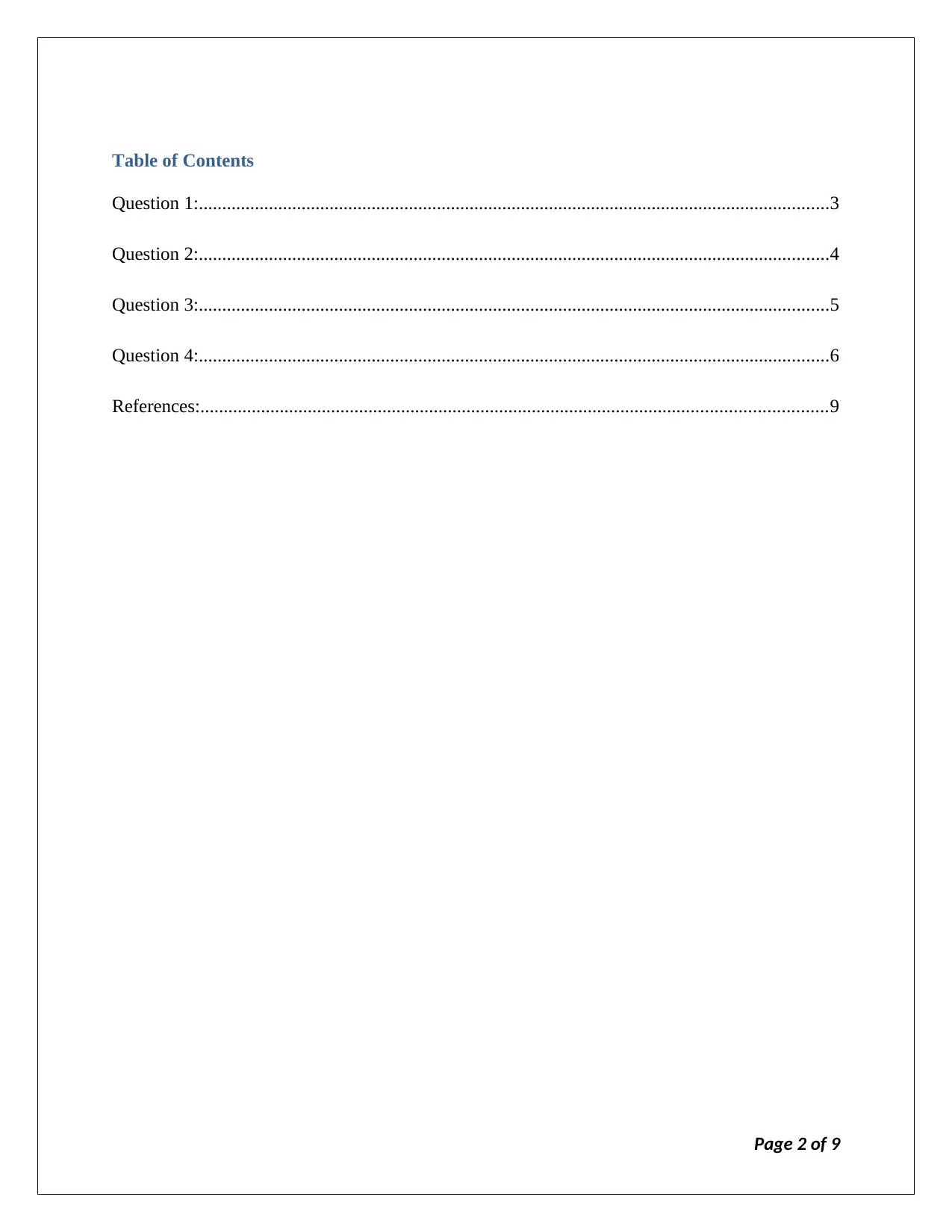
Table of Contents
Question 1:.......................................................................................................................................3
Question 2:.......................................................................................................................................4
Question 3:.......................................................................................................................................5
Question 4:.......................................................................................................................................6
References:......................................................................................................................................9
Page 2 of 9
Question 1:.......................................................................................................................................3
Question 2:.......................................................................................................................................4
Question 3:.......................................................................................................................................5
Question 4:.......................................................................................................................................6
References:......................................................................................................................................9
Page 2 of 9
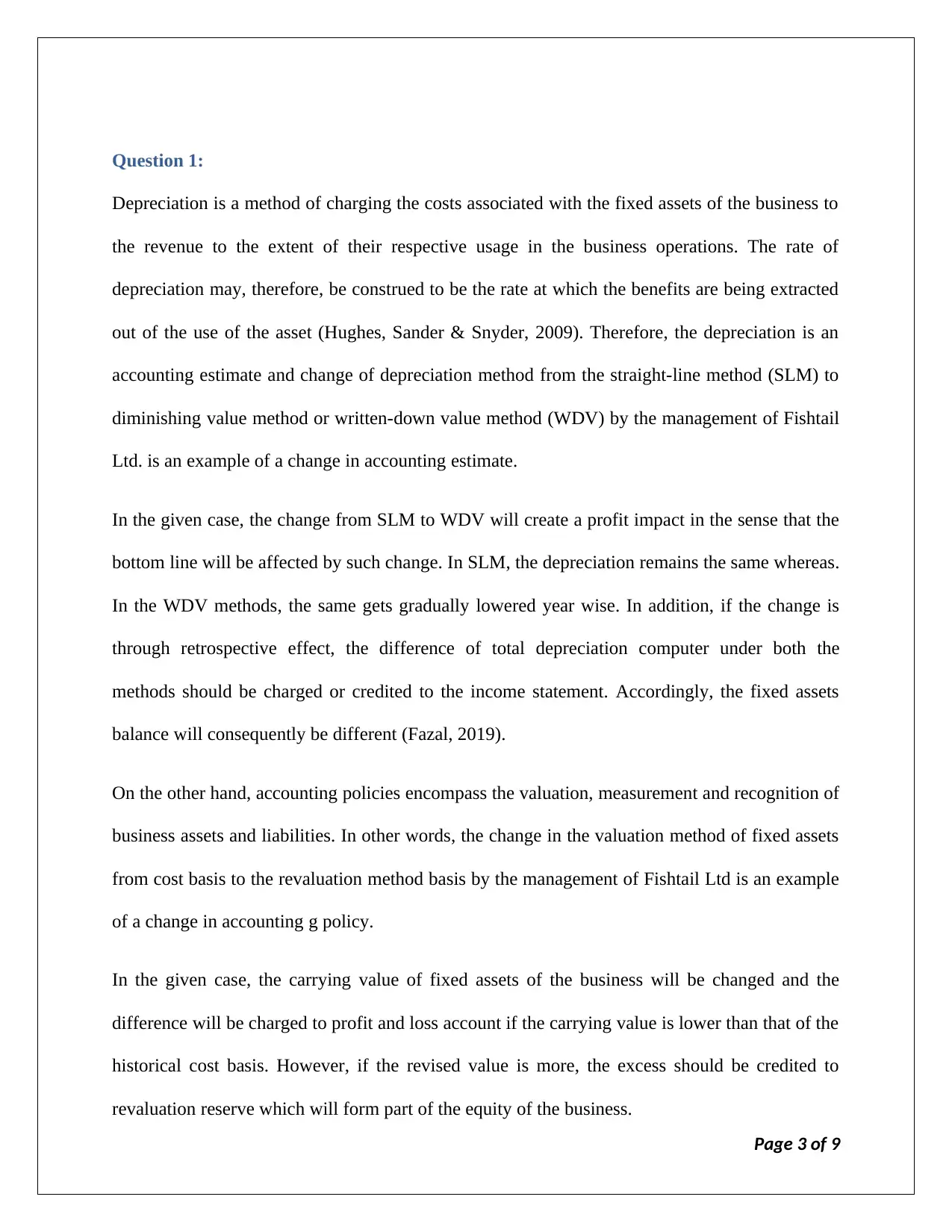
Question 1:
Depreciation is a method of charging the costs associated with the fixed assets of the business to
the revenue to the extent of their respective usage in the business operations. The rate of
depreciation may, therefore, be construed to be the rate at which the benefits are being extracted
out of the use of the asset (Hughes, Sander & Snyder, 2009). Therefore, the depreciation is an
accounting estimate and change of depreciation method from the straight-line method (SLM) to
diminishing value method or written-down value method (WDV) by the management of Fishtail
Ltd. is an example of a change in accounting estimate.
In the given case, the change from SLM to WDV will create a profit impact in the sense that the
bottom line will be affected by such change. In SLM, the depreciation remains the same whereas.
In the WDV methods, the same gets gradually lowered year wise. In addition, if the change is
through retrospective effect, the difference of total depreciation computer under both the
methods should be charged or credited to the income statement. Accordingly, the fixed assets
balance will consequently be different (Fazal, 2019).
On the other hand, accounting policies encompass the valuation, measurement and recognition of
business assets and liabilities. In other words, the change in the valuation method of fixed assets
from cost basis to the revaluation method basis by the management of Fishtail Ltd is an example
of a change in accounting g policy.
In the given case, the carrying value of fixed assets of the business will be changed and the
difference will be charged to profit and loss account if the carrying value is lower than that of the
historical cost basis. However, if the revised value is more, the excess should be credited to
revaluation reserve which will form part of the equity of the business.
Page 3 of 9
Depreciation is a method of charging the costs associated with the fixed assets of the business to
the revenue to the extent of their respective usage in the business operations. The rate of
depreciation may, therefore, be construed to be the rate at which the benefits are being extracted
out of the use of the asset (Hughes, Sander & Snyder, 2009). Therefore, the depreciation is an
accounting estimate and change of depreciation method from the straight-line method (SLM) to
diminishing value method or written-down value method (WDV) by the management of Fishtail
Ltd. is an example of a change in accounting estimate.
In the given case, the change from SLM to WDV will create a profit impact in the sense that the
bottom line will be affected by such change. In SLM, the depreciation remains the same whereas.
In the WDV methods, the same gets gradually lowered year wise. In addition, if the change is
through retrospective effect, the difference of total depreciation computer under both the
methods should be charged or credited to the income statement. Accordingly, the fixed assets
balance will consequently be different (Fazal, 2019).
On the other hand, accounting policies encompass the valuation, measurement and recognition of
business assets and liabilities. In other words, the change in the valuation method of fixed assets
from cost basis to the revaluation method basis by the management of Fishtail Ltd is an example
of a change in accounting g policy.
In the given case, the carrying value of fixed assets of the business will be changed and the
difference will be charged to profit and loss account if the carrying value is lower than that of the
historical cost basis. However, if the revised value is more, the excess should be credited to
revaluation reserve which will form part of the equity of the business.
Page 3 of 9
⊘ This is a preview!⊘
Do you want full access?
Subscribe today to unlock all pages.

Trusted by 1+ million students worldwide
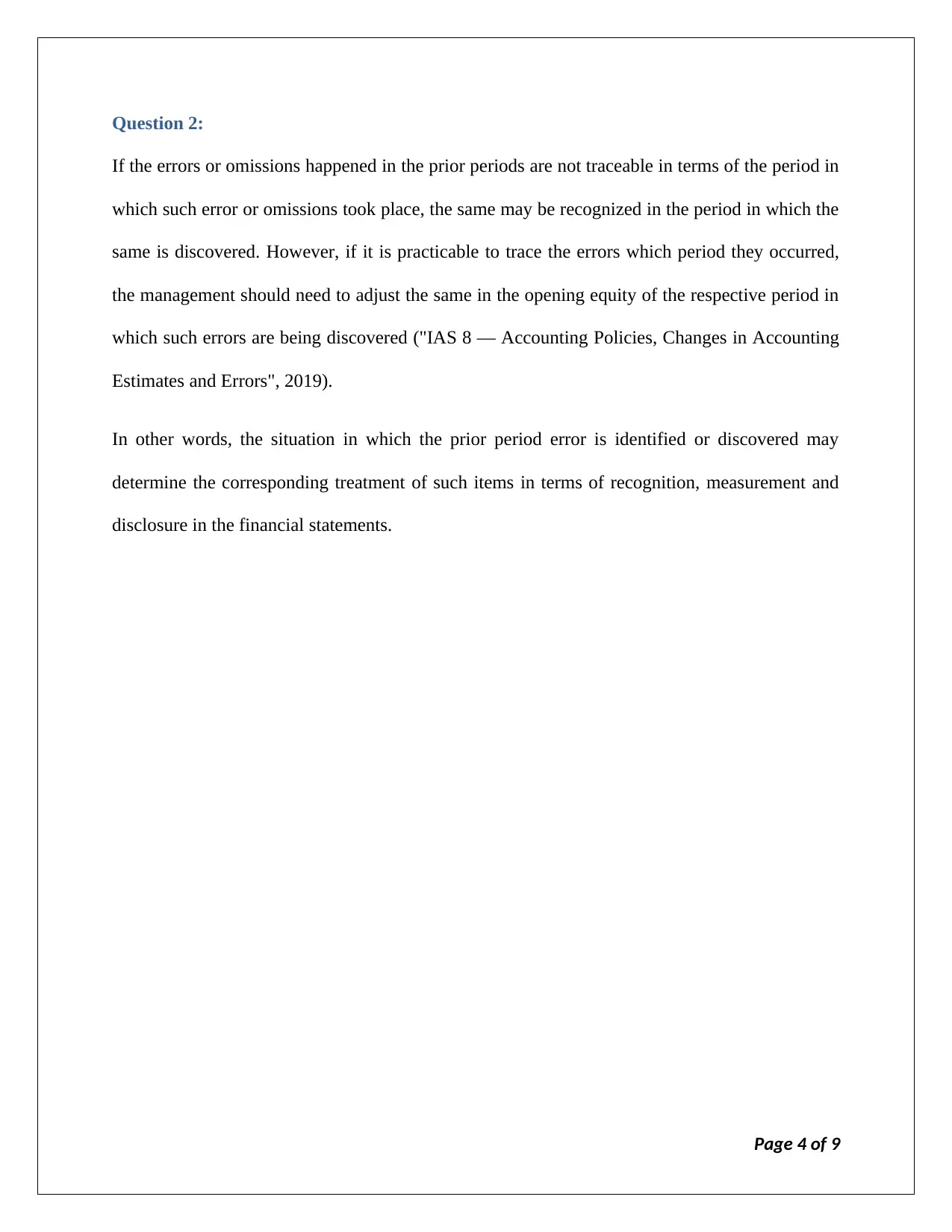
Question 2:
If the errors or omissions happened in the prior periods are not traceable in terms of the period in
which such error or omissions took place, the same may be recognized in the period in which the
same is discovered. However, if it is practicable to trace the errors which period they occurred,
the management should need to adjust the same in the opening equity of the respective period in
which such errors are being discovered ("IAS 8 — Accounting Policies, Changes in Accounting
Estimates and Errors", 2019).
In other words, the situation in which the prior period error is identified or discovered may
determine the corresponding treatment of such items in terms of recognition, measurement and
disclosure in the financial statements.
Page 4 of 9
If the errors or omissions happened in the prior periods are not traceable in terms of the period in
which such error or omissions took place, the same may be recognized in the period in which the
same is discovered. However, if it is practicable to trace the errors which period they occurred,
the management should need to adjust the same in the opening equity of the respective period in
which such errors are being discovered ("IAS 8 — Accounting Policies, Changes in Accounting
Estimates and Errors", 2019).
In other words, the situation in which the prior period error is identified or discovered may
determine the corresponding treatment of such items in terms of recognition, measurement and
disclosure in the financial statements.
Page 4 of 9
Paraphrase This Document
Need a fresh take? Get an instant paraphrase of this document with our AI Paraphraser
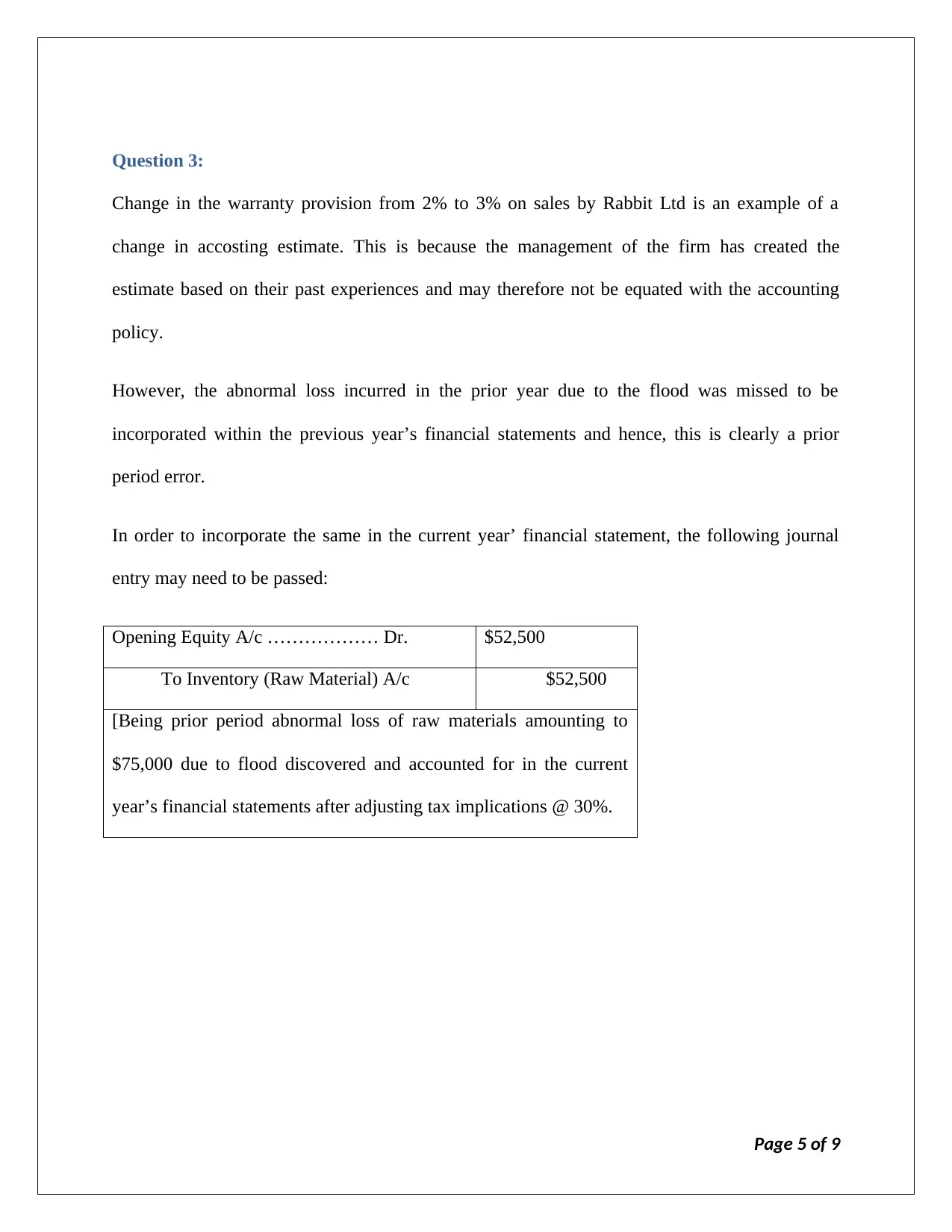
Question 3:
Change in the warranty provision from 2% to 3% on sales by Rabbit Ltd is an example of a
change in accosting estimate. This is because the management of the firm has created the
estimate based on their past experiences and may therefore not be equated with the accounting
policy.
However, the abnormal loss incurred in the prior year due to the flood was missed to be
incorporated within the previous year’s financial statements and hence, this is clearly a prior
period error.
In order to incorporate the same in the current year’ financial statement, the following journal
entry may need to be passed:
Opening Equity A/c ……………… Dr. $52,500
To Inventory (Raw Material) A/c $52,500
[Being prior period abnormal loss of raw materials amounting to
$75,000 due to flood discovered and accounted for in the current
year’s financial statements after adjusting tax implications @ 30%.
Page 5 of 9
Change in the warranty provision from 2% to 3% on sales by Rabbit Ltd is an example of a
change in accosting estimate. This is because the management of the firm has created the
estimate based on their past experiences and may therefore not be equated with the accounting
policy.
However, the abnormal loss incurred in the prior year due to the flood was missed to be
incorporated within the previous year’s financial statements and hence, this is clearly a prior
period error.
In order to incorporate the same in the current year’ financial statement, the following journal
entry may need to be passed:
Opening Equity A/c ……………… Dr. $52,500
To Inventory (Raw Material) A/c $52,500
[Being prior period abnormal loss of raw materials amounting to
$75,000 due to flood discovered and accounted for in the current
year’s financial statements after adjusting tax implications @ 30%.
Page 5 of 9
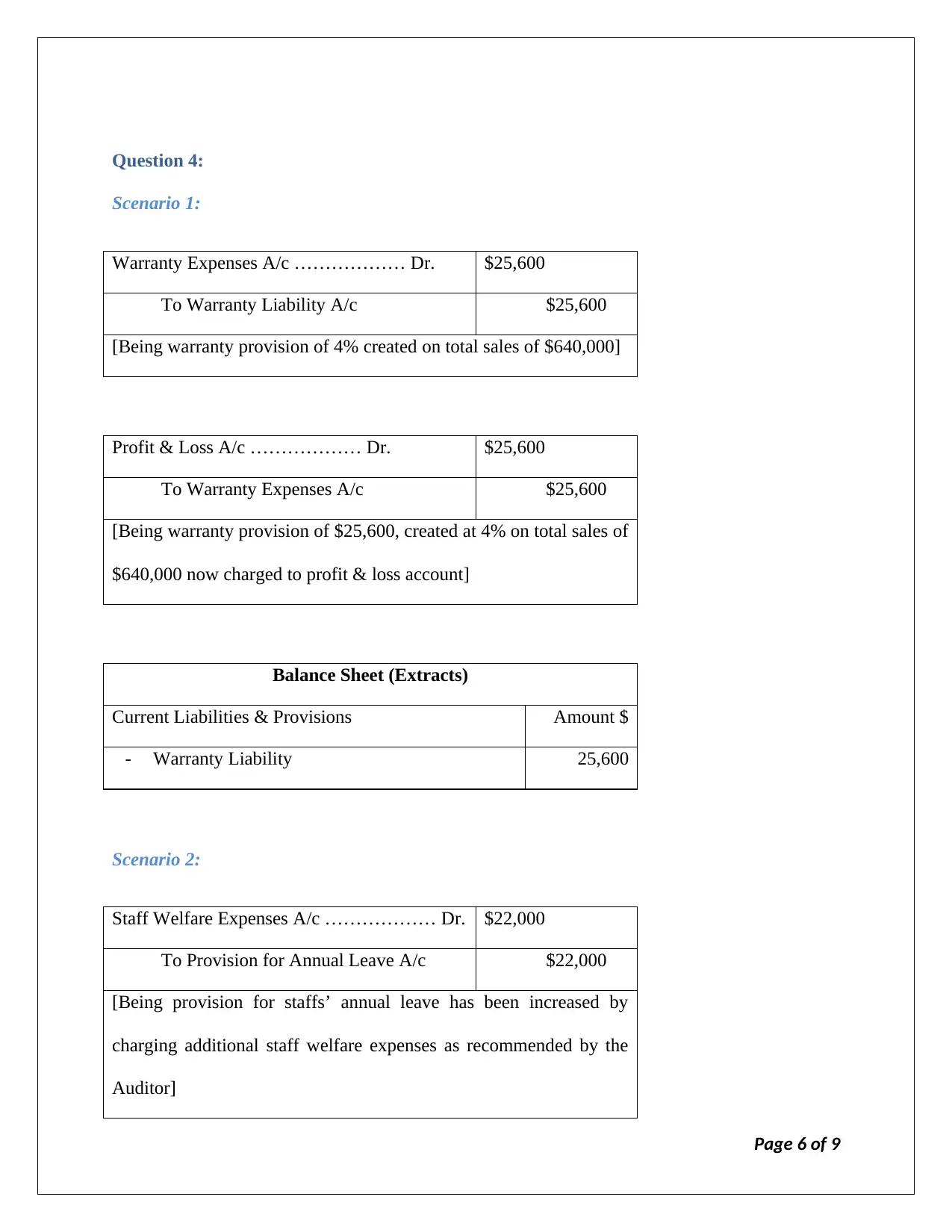
Question 4:
Scenario 1:
Warranty Expenses A/c ……………… Dr. $25,600
To Warranty Liability A/c $25,600
[Being warranty provision of 4% created on total sales of $640,000]
Profit & Loss A/c ……………… Dr. $25,600
To Warranty Expenses A/c $25,600
[Being warranty provision of $25,600, created at 4% on total sales of
$640,000 now charged to profit & loss account]
Balance Sheet (Extracts)
Current Liabilities & Provisions Amount $
- Warranty Liability 25,600
Scenario 2:
Staff Welfare Expenses A/c ……………… Dr. $22,000
To Provision for Annual Leave A/c $22,000
[Being provision for staffs’ annual leave has been increased by
charging additional staff welfare expenses as recommended by the
Auditor]
Page 6 of 9
Scenario 1:
Warranty Expenses A/c ……………… Dr. $25,600
To Warranty Liability A/c $25,600
[Being warranty provision of 4% created on total sales of $640,000]
Profit & Loss A/c ……………… Dr. $25,600
To Warranty Expenses A/c $25,600
[Being warranty provision of $25,600, created at 4% on total sales of
$640,000 now charged to profit & loss account]
Balance Sheet (Extracts)
Current Liabilities & Provisions Amount $
- Warranty Liability 25,600
Scenario 2:
Staff Welfare Expenses A/c ……………… Dr. $22,000
To Provision for Annual Leave A/c $22,000
[Being provision for staffs’ annual leave has been increased by
charging additional staff welfare expenses as recommended by the
Auditor]
Page 6 of 9
⊘ This is a preview!⊘
Do you want full access?
Subscribe today to unlock all pages.

Trusted by 1+ million students worldwide
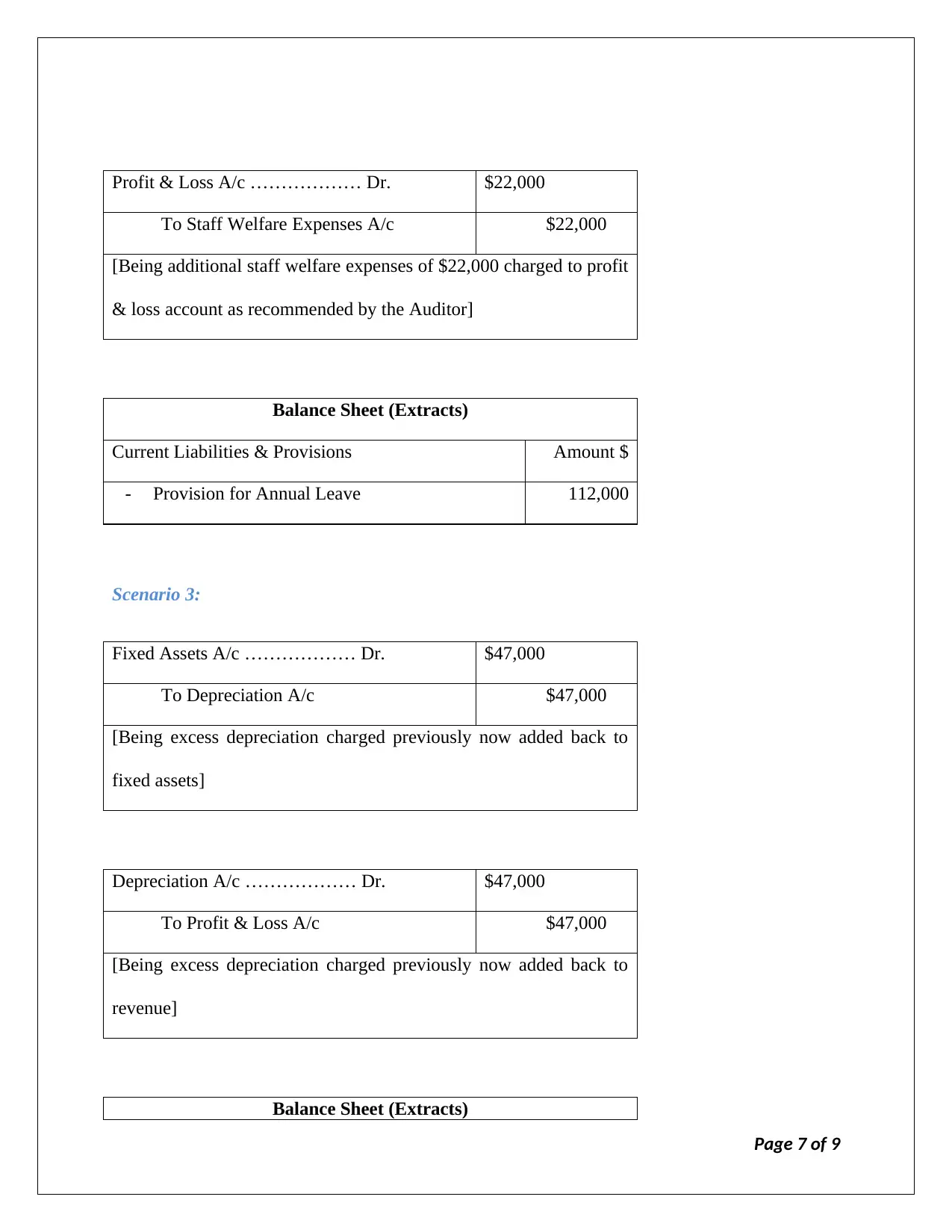
Profit & Loss A/c ……………… Dr. $22,000
To Staff Welfare Expenses A/c $22,000
[Being additional staff welfare expenses of $22,000 charged to profit
& loss account as recommended by the Auditor]
Balance Sheet (Extracts)
Current Liabilities & Provisions Amount $
- Provision for Annual Leave 112,000
Scenario 3:
Fixed Assets A/c ……………… Dr. $47,000
To Depreciation A/c $47,000
[Being excess depreciation charged previously now added back to
fixed assets]
Depreciation A/c ……………… Dr. $47,000
To Profit & Loss A/c $47,000
[Being excess depreciation charged previously now added back to
revenue]
Balance Sheet (Extracts)
Page 7 of 9
To Staff Welfare Expenses A/c $22,000
[Being additional staff welfare expenses of $22,000 charged to profit
& loss account as recommended by the Auditor]
Balance Sheet (Extracts)
Current Liabilities & Provisions Amount $
- Provision for Annual Leave 112,000
Scenario 3:
Fixed Assets A/c ……………… Dr. $47,000
To Depreciation A/c $47,000
[Being excess depreciation charged previously now added back to
fixed assets]
Depreciation A/c ……………… Dr. $47,000
To Profit & Loss A/c $47,000
[Being excess depreciation charged previously now added back to
revenue]
Balance Sheet (Extracts)
Page 7 of 9
Paraphrase This Document
Need a fresh take? Get an instant paraphrase of this document with our AI Paraphraser
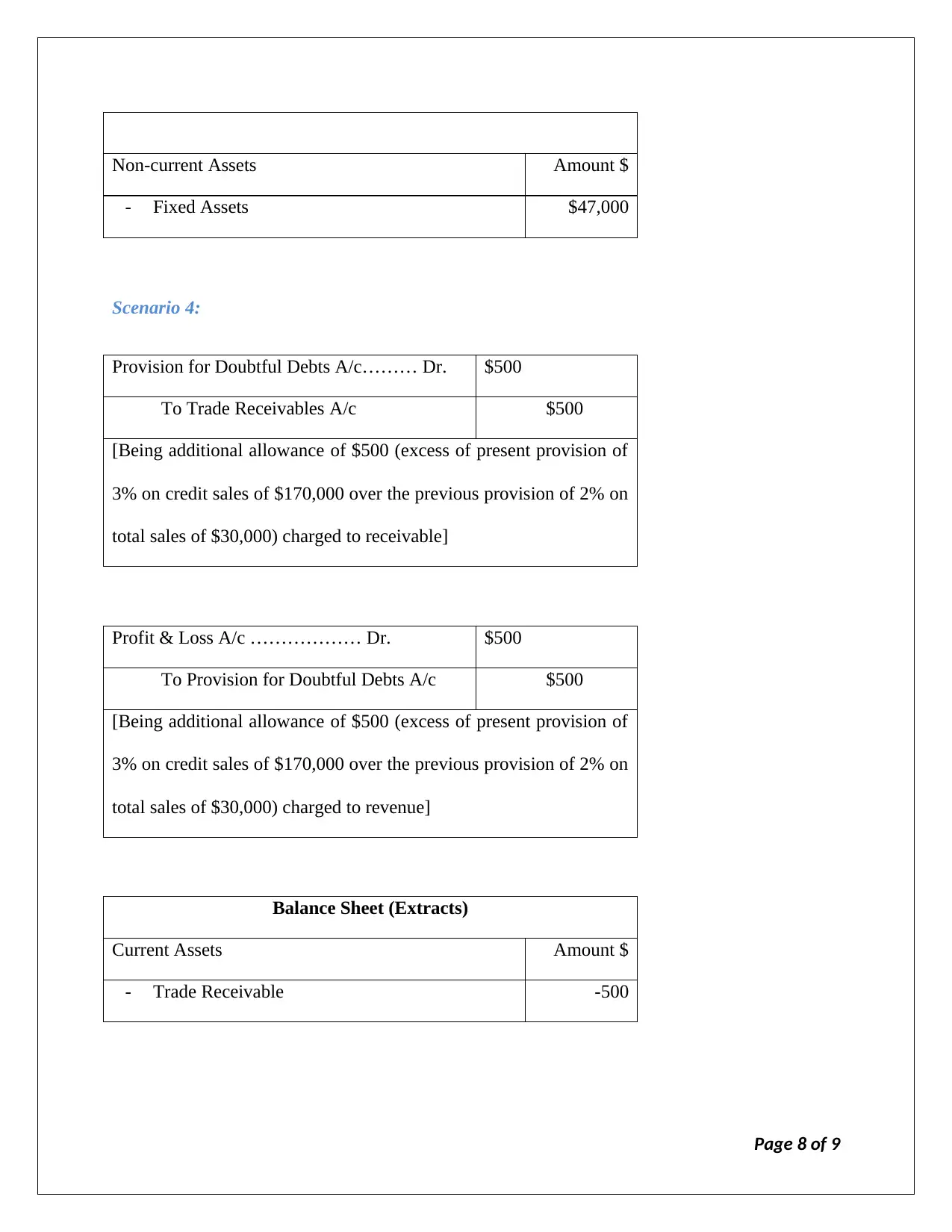
Non-current Assets Amount $
- Fixed Assets $47,000
Scenario 4:
Provision for Doubtful Debts A/c……… Dr. $500
To Trade Receivables A/c $500
[Being additional allowance of $500 (excess of present provision of
3% on credit sales of $170,000 over the previous provision of 2% on
total sales of $30,000) charged to receivable]
Profit & Loss A/c ……………… Dr. $500
To Provision for Doubtful Debts A/c $500
[Being additional allowance of $500 (excess of present provision of
3% on credit sales of $170,000 over the previous provision of 2% on
total sales of $30,000) charged to revenue]
Balance Sheet (Extracts)
Current Assets Amount $
- Trade Receivable -500
Page 8 of 9
- Fixed Assets $47,000
Scenario 4:
Provision for Doubtful Debts A/c……… Dr. $500
To Trade Receivables A/c $500
[Being additional allowance of $500 (excess of present provision of
3% on credit sales of $170,000 over the previous provision of 2% on
total sales of $30,000) charged to receivable]
Profit & Loss A/c ……………… Dr. $500
To Provision for Doubtful Debts A/c $500
[Being additional allowance of $500 (excess of present provision of
3% on credit sales of $170,000 over the previous provision of 2% on
total sales of $30,000) charged to revenue]
Balance Sheet (Extracts)
Current Assets Amount $
- Trade Receivable -500
Page 8 of 9
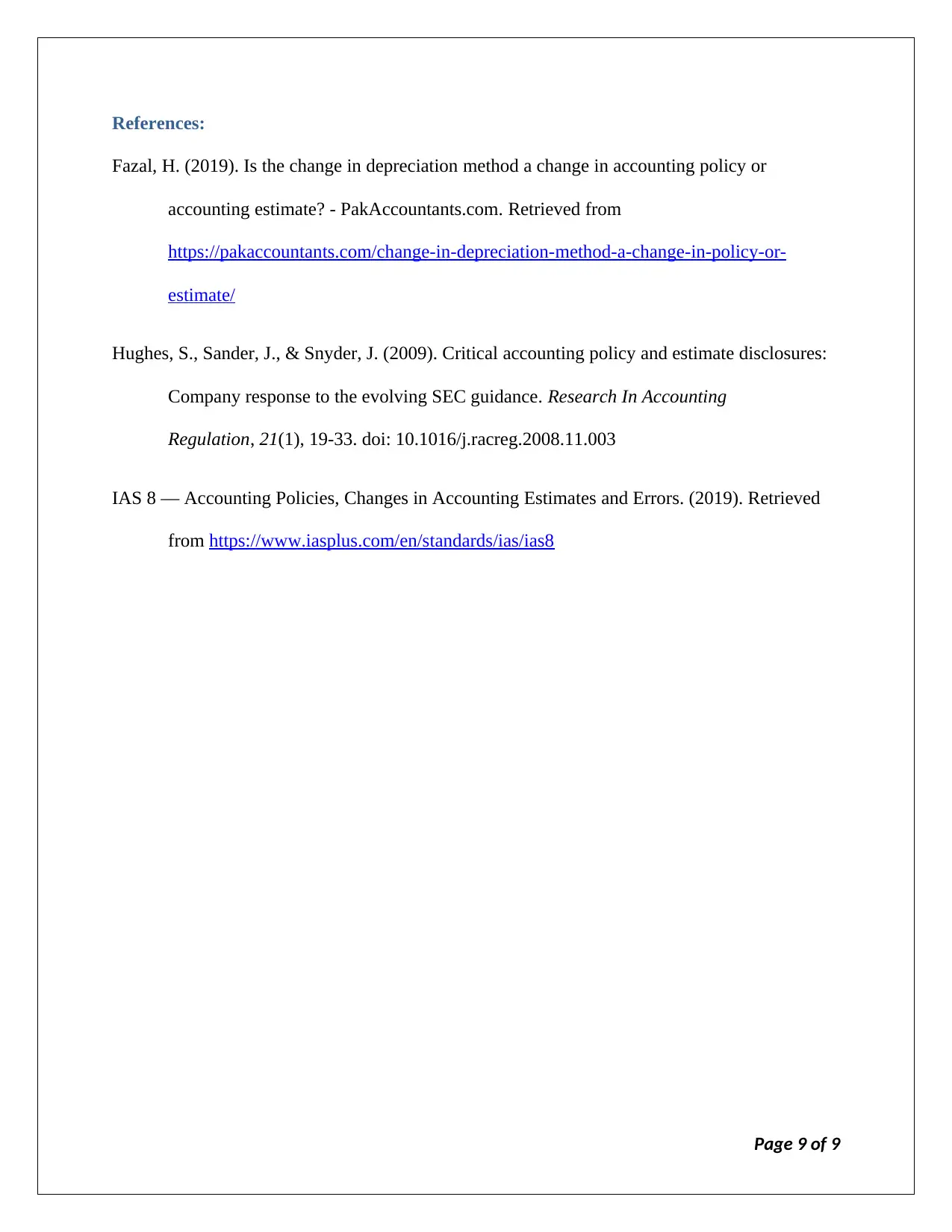
References:
Fazal, H. (2019). Is the change in depreciation method a change in accounting policy or
accounting estimate? - PakAccountants.com. Retrieved from
https://pakaccountants.com/change-in-depreciation-method-a-change-in-policy-or-
estimate/
Hughes, S., Sander, J., & Snyder, J. (2009). Critical accounting policy and estimate disclosures:
Company response to the evolving SEC guidance. Research In Accounting
Regulation, 21(1), 19-33. doi: 10.1016/j.racreg.2008.11.003
IAS 8 — Accounting Policies, Changes in Accounting Estimates and Errors. (2019). Retrieved
from https://www.iasplus.com/en/standards/ias/ias8
Page 9 of 9
Fazal, H. (2019). Is the change in depreciation method a change in accounting policy or
accounting estimate? - PakAccountants.com. Retrieved from
https://pakaccountants.com/change-in-depreciation-method-a-change-in-policy-or-
estimate/
Hughes, S., Sander, J., & Snyder, J. (2009). Critical accounting policy and estimate disclosures:
Company response to the evolving SEC guidance. Research In Accounting
Regulation, 21(1), 19-33. doi: 10.1016/j.racreg.2008.11.003
IAS 8 — Accounting Policies, Changes in Accounting Estimates and Errors. (2019). Retrieved
from https://www.iasplus.com/en/standards/ias/ias8
Page 9 of 9
⊘ This is a preview!⊘
Do you want full access?
Subscribe today to unlock all pages.

Trusted by 1+ million students worldwide
1 out of 9
Related Documents
Your All-in-One AI-Powered Toolkit for Academic Success.
+13062052269
info@desklib.com
Available 24*7 on WhatsApp / Email
![[object Object]](/_next/static/media/star-bottom.7253800d.svg)
Unlock your academic potential
Copyright © 2020–2025 A2Z Services. All Rights Reserved. Developed and managed by ZUCOL.




